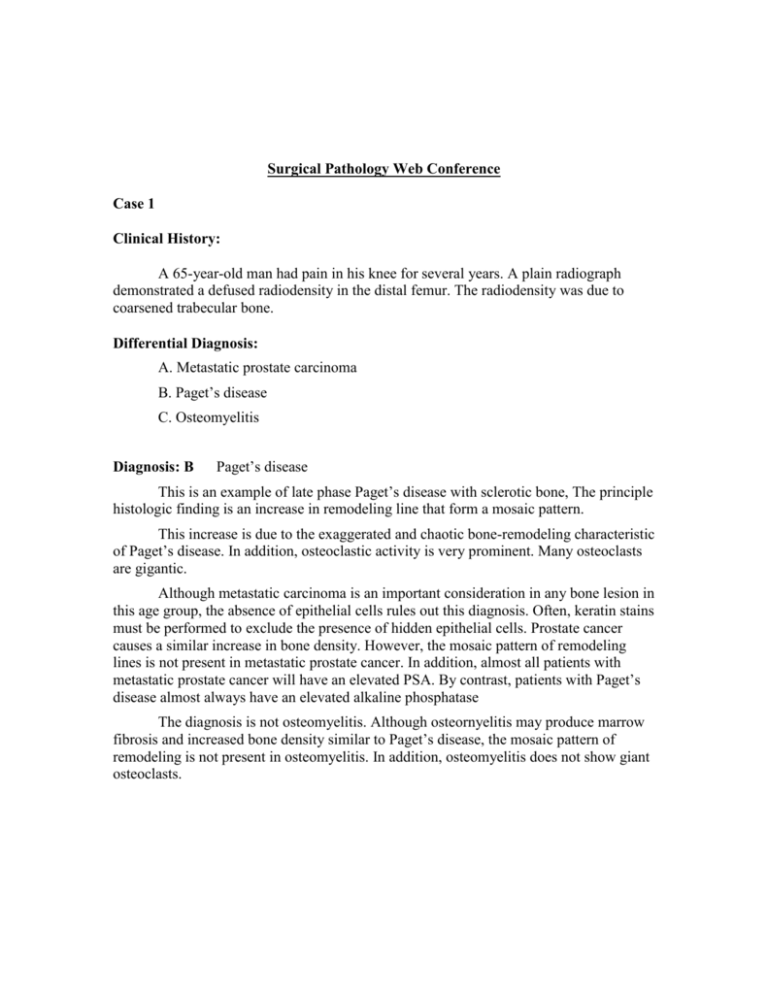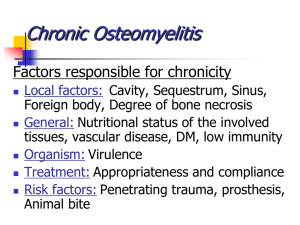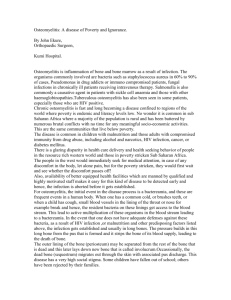Surgical Pathology Web Conference
advertisement

Surgical Pathology Web Conference Case 1 Clinical History: A 65-year-old man had pain in his knee for several years. A plain radiograph demonstrated a defused radiodensity in the distal femur. The radiodensity was due to coarsened trabecular bone. Differential Diagnosis: A. Metastatic prostate carcinoma B. Paget’s disease C. Osteomyelitis Diagnosis: B Paget’s disease This is an example of late phase Paget’s disease with sclerotic bone, The principle histologic finding is an increase in remodeling line that form a mosaic pattern. This increase is due to the exaggerated and chaotic bone-remodeling characteristic of Paget’s disease. In addition, osteoclastic activity is very prominent. Many osteoclasts are gigantic. Although metastatic carcinoma is an important consideration in any bone lesion in this age group, the absence of epithelial cells rules out this diagnosis. Often, keratin stains must be performed to exclude the presence of hidden epithelial cells. Prostate cancer causes a similar increase in bone density. However, the mosaic pattern of remodeling lines is not present in metastatic prostate cancer. In addition, almost all patients with metastatic prostate cancer will have an elevated PSA. By contrast, patients with Paget’s disease almost always have an elevated alkaline phosphatase The diagnosis is not osteomyelitis. Although osteornyelitis may produce marrow fibrosis and increased bone density similar to Paget’s disease, the mosaic pattern of remodeling is not present in osteomyelitis. In addition, osteomyelitis does not show giant osteoclasts. Case 2 Clinical History: A 70-year-old woman had pain in her arm. A radiograph showed an aggressive lytic lesion involving much of her proximal radius. Differential Diagnosis: A. Lymphoma B. Metastatic carcinoma C. Multiple myeloma D. Osteomyelitis Diagnosis: C Multiple myeloma Multiple myeloma almost always produces lytic lesions in bone. In most cases, there are multiple lesions. However, occasionally a solitary myeloma may present as a single lytic lesion with no other sites of involvement. Only a staging study can differentiate multiple myeloma from solitary myeloma. Multiple myeloma consists of sheets of plasma cells. Sometimes they may be so poorly differentiated as to their plasmacytic nature. However, a CD138 stain should be performed on any round cell tumors. CD 138 is specific for plasma cells. To corroborate the neoplastic nature of these cells, a kappa and lambda immunostain should be performed. Myeloma will be monoclonal and either for only kappa or only lambda. Although lymphoma of bone occurs in this age group and shows sheets of rounded cells, the plasmacytoid nature is usually not present. Furthermore, a CD 138 stain will be negative. Usually, primary lymphomas of bone are B-cell lymphomas and stain strongly with a CD2O stain. The lesion is not metastatic carcinoma because epithelial cells are not present. In this age group metastatic carcinoma should always be a strong consideration. Often, a keratin stain must be performed to absolutely exclude the diagnosis of metastatic carcinoma. Although osteomyelitis may demonstrate many plasma cells, this case is not osteomyelitis because the plasma cells will be monoclonal. In addition, chronic osteomyelitis produces a radiodense pattern unlike this case that shows an aggressive radiolytic pattern. Case 3 Clinical History: A 20-year-old man had a swollen big toe. One-year prior he had dropped a brick on his toe. The radiograph demonstrated a bony protrusion arising from the dorsal aspect of the great toe distal phalange. Differential Diagnoses: A. Subungual exostosis B. Osteochondroma C. Myositis ossificans D Parosteal osteosarcoma Diagnosis: A subungual exostosis The radiographic image is critical for the diagnosis in this case. The radiographic pattern is diagnostic of a subungual exostosis. This disease is a bony growth underneath the nail, usually as a result of trauma. There is woven bone proliferation in the soft tissues in periosteum on the dorsal aspect of the distal phalange. There is a distinct zonal pattern of bone formation with the more immature bone closer to the nail. Eventually the nail can be pushed up at a right angle to the toe. The lesion is not an osteochondroma because osteochondromas are developmental lesions and do not occur in the phalanges. A rare exception is in cases of hereditary multiple exostosis. Osteochondromas usually occur in the long bones and have a very distinctive cartilage cap. Although myositis ossificans is a reasonable alternative consideration, this lesion is not officially myositis ossificans because no muscle is present. Indeed myositis ossificans is a reactive proliferation of woven bone, as is this case. However, in this location, the lesion is known as a subungual exostosis. The zonal pattern and the lack of atypia in the stroma between the new bone formations exclude the possibility of a parosteal osteosarcoma. Moreover parosteal osteosarcomas in the phalanges are extremely rare. Case 4 Clinical History: A 30-year-old man had pain in his lower leg. A radiograph demonstrated a lytic expansile lesion in his distal tibia. An MRI showed multiple fluid-fluid levels. Differential Diagnoses: A. Telangiectactic osteosarcoma B. Giant Cell Tumor C. Aneurysmal bone cyst Diagnosis: C Aneurysmal bone cyst The MRI pattern in this case is characteristic of aneurysmal bone cyst. The fluidfluid levels visible on a T2 MRI represent blood filled lakes present in the lesion. These blood filled lakes are the hallmark of an aneurysmal bone cyst. The stroma separating these blood filled cavities consists of fibrous tissue with numerous multinucleated giant cells and reactive bone. Although telangiectatic osteosarcomas can have a similar radiographic pattern, especially on the MRI, the absence of frank sarcomatous strorna eliminates the possibilityof osteosarcoma. Telangiectactic osteosareomas have blood filled lakes similar to aneurysmal bone cysts, but they are filled with sheets of large pleomorphic, atypical osteoblasts. The lesion is not a giant cell tumor. Although giant cells are prominent in aneurysmal bone cysts, the metaphyseal location of this lesion excludes the possibility of this being a giant cell tumor that always involves the epiphyseal end of a long bone. Aneurysmal bone cysts may be a component of giant cell tumors, but this case represents a pure aneurysmal bone cyst. Case 5 Clinical History: A 20-year-old man had pain in his shoulder for 6 months. The radiograph demonstrated a poorly defined radiolytic and radiodense lesion with cortical destruction. Differential Diagnoses: A. Osteosarcoma B. Osteoblastoma C. Malignant fibrous histiocytoma D Parosteal osteosarcoma Diagnosis: A Osteosarcoma Osteosarcoma is the most common primary malignant bone tumor and usually occurs in young adults and adolescents, as in this case. Histologically, sheets of atypical and pleomorphic sarcoma cells make pink seams of osteoid. This feature designates these cells as osteoblasts and the lesion, therefore, as an osteosarcoma. The radiograph in this case is diagnostic. The lesion is not an osteoblastoma. Osteoblastomas are well-defined lytic lesions. They manufacture abundant osteoid, but they are not composed of atypical and pleomorphic osteoblasts. The lesion is not a malignant fibrous histiocytoma because of the extensive osteoid formation. Some osteoid osteogenic sarcomas may have a predominant histologic pattern of malignant fibrous histiocytoma, the presence of osteoid formation requires the diagnosis of osteosarcoma. The lesion is not a parosteal osteosarcoma because parosteal osteosarcoma is entirely a surface lesion. This case involves the medullary canal of bone. Occasionally, a CT scan must be performed to see if the medually canal is involved when there is extensive soft tissue involvement with osteosarcoma. Moreover parosteal osteosarcomas are low-grade sarcomas and do not show severe pleomorphism. Case 6 Clinical History: A 45-year old man had pain in both his legs. Radiographs demonstrated defuse radiodensity in a zonal pattern that involved both femurs. In addition, this gentleman had defused radiodensities involving many other long bones. A biopsy showed numerous histiocytic-like cells, and an S100 stain was negative. Differential Diagnosis: A. Osteomyelitis B. Langerhans’ cell histiocytosis C. Erdheim-Chester disease D. Rosai-Dorfman disease Diagnosis: C Erdheim-Chester disease Erdheim-Chester disease is a systemic proliferation of histiocytes that involve many bones of the skeleton. In any one bone, a radiographic pattern is similar to chronic osteomyelitis. However, unlike chronic osteomyelitis, many bones in the skeleton are involved. In addition, wound cultures in Erdheim-Chester disease are negative. The lesion is not osteomyelitis because of the multiple bones involved and because cultures were negative. Otherwise, the histologic pattern of any one lesion (as well as the radiographic pattern) could be highly suggestive of osteomyelitis. The lesion is not Langerhans’ cell histiocytosis because the S100 stain is negative. Langerhans’ cell histiocytosis is a histiocytic proliferation that may involve multiple bones. However, the lesions are usually punched out and lytic, and they do not form a pattern of irregular radiodensity as in this case. Rosai-Dorfman disease is also a histiocytic proliferation that occasionally may involve one or more bones. This disease usually involves lymph nodes, but has been reported in a wide variety of visceral locations, including bone. S100 stain is positive in Rosai-Dorfman disease, and this case could not be given that diagnosis.









